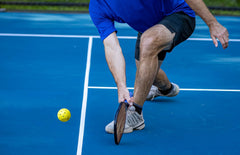In recent years, a surprising contender has emerged in the race for America's most rapidly expanding sport: pickleball. This paddle sport, which marries elements of tennis, badminton, and table tennis, has been capturing hearts and communities across the nation. But what makes pickleball not just a game, but a phenomenon? Let's dive in.
A Brief History of Pickleball
Conceived in 1965 on Bainbridge Island, Washington, pickleball was initially a backyard family game invented to entertain children. However, its appeal quickly transcended age groups, evolving into a sport with formalized rules and dedicated courts. Today, it stands as a testament to the power of simplicity and inclusivity in sports.
The Lure of Pickleball: Accessibility and Inclusivity
One of pickleball's most compelling attributes is its accessibility. The game's straightforward rules and minimal equipment requirements make it welcoming for newcomers. Unlike many other sports, pickleball can be enjoyed across generations, from young children to seniors, providing a rare common ground in physical activity.
The cost of entry is notably low, with public courts often available for free or at a minimal charge. This ease of access has been a significant factor in pickleball's spread, making it a popular choice in community centers, parks, and retirement communities alike.
The Social Heart of Pickleball
Beyond the physical gameplay, pickleball fosters a sense of community and connection. It is not uncommon for local courts to become bustling social hubs where friendships are formed and strengthened. The sport's inherently social nature, combined with the doubles format being the most popular way to play, emphasizes teamwork and communication.
The Wellness Factor
Pickleball offers substantial physical and mental health benefits. Players enjoy a full-body workout that improves cardiovascular health, balance, and agility, with a comparatively low risk of injury. Additionally, the joy and satisfaction derived from playing can significantly boost mental well-being and reduce stress levels.
Organizational Backbone
The structured growth of pickleball can be attributed in part to the support from organizations like the USA Pickleball Association (USAPA), which promotes the sport through the establishment of standardized rules, rankings, and organized tournaments. This organizational framework has been crucial in formalizing the sport and supporting its expansion across the country.
Media and Celebrity Spotlight
Increased media attention and celebrity endorsements have propelled pickleball into the national spotlight. Stories of celebrities and athletes taking up the paddle have added a layer of intrigue and glamour, drawing more people to the courts.
The Future of Pickleball
As pickleball continues to grow, its impact on American sports culture cannot be overstated. With more courts being built and programs being introduced in schools, the sport is setting a precedent for how accessibility, community, and health benefits can drive the popularity of a physical activity.
The inclusive nature of pickleball, combined with its health benefits and social appeal, positions it as a cornerstone of community sports. Its continued expansion speaks volumes about the changing landscape of recreational activities in America, where the value of connection and inclusivity cannot be underestimated.
In conclusion, pickleball's rise to prominence is a testament to the power of a sport that is accessible, engaging, and inherently social. As more Americans pick up a paddle, the future of pickleball looks not only bright but boundless.













